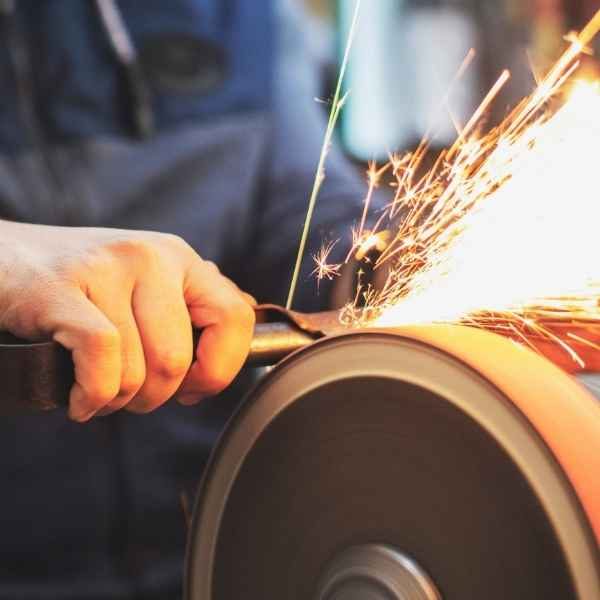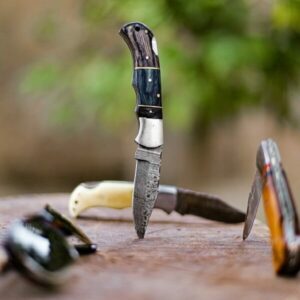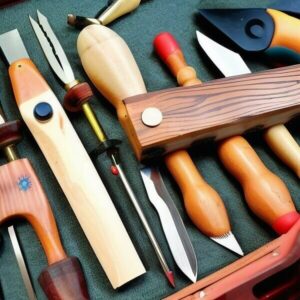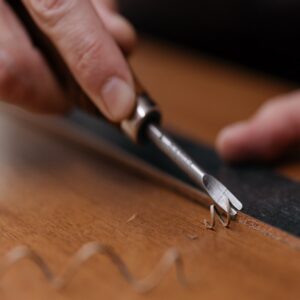If you’re a woodcarver, then you know that keeping your tools sharp is essential to producing quality work. A dull blade can make even the simplest carving project much more difficult and time-consuming. In this guide, we will discuss how to keep your wood carving tools sharp using a variety of methods. We’ll also cover some tips on avoiding common mistakes that can cause blades to go dull quickly. So, whether you’re a beginner or an experienced carver, read on for the ultimate guide to keeping your tools razor-sharp!
How to Sharpen Your Blades
Sharpening your wood carving tools is an important part of maintaining them. There are a few different ways to sharpen blades, and the best method will depend on the type of blade you’re using. For instance, chisels can be sharpened with a honing stone, while knives can be sharpened with a honing rod.
Below, we’ll discuss how to sharpen each type. With a little practice, you’ll be able to get your blades razor-sharp in no time! Here are a few methods that you can use to sharpen your blades:
Sharpening Stones
Sharpening stones are probably the most popular way to sharpen blades. There are two types of stones commonly used for sharpening: oil stones and water stones. Oil stones are coated in a fine abrasive that helps to sharpen the blade, while water stones contain a layer of microscopic particles that wear away as you sharpen, providing a constantly-refreshing sharpening surface.
Oil Stones
If your blades are dull and need a lot of work, start by using an oil stone. Coarse-grit stones are good for removing a lot of material, while finer-grit stones are better for honing and finishing the blade. To use an oil stone, apply a small amount of honing oil to the surface and rub the blade against the stone in a circular motion. Be sure to keep the blade at a consistent angle and apply even pressure. You should also alternate sides with each stroke to ensure that the blade is evenly sharpened.
Water Stones
Water stones work similarly, but you don’t need to use any oil. Just soak the stone in water for a few minutes before using it, and then rub the blade against the surface in a circular motion. Again, be sure to keep the blade at a consistent angle and apply even pressure. You should also alternate sides with each stroke.
Diamond Stones
Another option for sharpening blades is a diamond stone. Diamond stones are available in both fine-grit and coarse-grit versions, and they work best on blades that are already quite sharp. To use a diamond stone, apply a small amount of honing oil to the surface and rub the blade against the stone in a circular motion. Be sure to keep the blade at a consistent angle and apply even pressure. You should also alternate sides with each stroke.
Ceramic Stones
Ceramic stones are a great way to keep your wood carving tools sharp. They are available in different grits, so you can find the one that is best for your needs. To use a ceramic stone, soak it in water for a few minutes before using it. Then, rub the blade of your tool against the stone in a circular motion. Make sure to apply pressure and move the blade quickly across the stone to get the best results. Kaiden ceramic sharpener is a good example.
Sharpening Guides
If you’re uncomfortable using a sharpening stone, or if your blades are only slightly dull, you can use a sharpening guide to help you sharpen them. A sharpening guide is a simple device that helps you maintain a consistent angle while sharpening. There are a number of different types available, but most consist of two metal bars that hold the blade at a fixed angle.
To use a sharpening guide, attach the blade to the bars and then position the guide against the edge of the blade. Move the guide along the length of the blade, applying pressure as you go, and sharpen each side until it’s razor-sharp.
Sharpening Jigs
A sharpening jig is a more advanced tool that helps you sharpen blades with intricate shapes and details. It consists of a platform with several adjustable guides that hold the blade at a variety of different angles.
To use a sharpening jig, first, adjust the guides to the desired angle and then attach the blade to the platform. Gently push the blade against the guides, being careful not to apply too much pressure. Slowly move the blade back and forth until it is sharp.
Honing Rods
A honing rod is a simple tool that helps you keep your blades sharp. It is a long, thin rod made of either steel or ceramic, and it has a fine-grit surface that helps to polish the blade.
To use a honing rod, hold the rod at a 45-degree angle and run the blade along the length of the rod. Be sure to apply pressure and move the blade quickly across the surface to get the best results.
Should I Wash My Tools After Sharpening?
Yes, you should always wash your tools after sharpening them. This will remove any metal shavings or debris that may be on the surface of the blade. To clean your tools, simply rinse them off with warm water and soap. Then, dry them with a clean cloth.
How Can I Know If My Carving Tool Is Sharp Enough?
The best way to know if your carving tool is sharp enough is to test it on a piece of wood. If the blade cuts cleanly and smoothly, then it is sharp enough. If the blade leaves behind jagged edges or catches on the wood, then it needs to be sharper.
You can also use a honing rod or sharpening stone to test the sharpness of your blade. Simply run the blade along the surface of the stone or rod. If it cuts cleanly, then it is sharp enough. If not, then you need to continue sharpening.
How To Prevent My Tools Becoming Dull?
There are a few things you can do to prevent your tools from becoming dull. First, always store your tools in a safe place when not in use. This will protect them from being damaged or knocked around. Second, regularly clean and oil your tools to keep them from rusting. Finally, sharpen your blades regularly to keep them sharp.
By following these simple tips, you can keep your wood carving tools sharp and in good condition for years to come.
Safety Rules For Sharpening Your Tools
Always be careful when sharpening your tools. Here are a few safety rules to keep in mind:
- Always wear safety glasses when sharpening your tools.
- Keep children and pets away from the area while you’re sharpening your tools.
- Don’t over-sharpen your tools. A blade that is too sharp can be more dangerous than a dull blade.
- Don’t use excessive pressure when sharpening your tools. Applying too much pressure can cause the blade to break or shatter.
- Be patient and take your time while sharpening your tools. Rushing through the process can lead to mistakes and accidents.
Conclusion
In conclusion, there are many different ways to keep your wood carving tools sharp. If your blades are dull and need a lot of work, start by using sharpening stones like an oil stone. Coarse-grit stones are good for removing a lot of material, while finer-grit stones are good for polishing the blade. If your blades are only slightly dull, you can use a sharpening guide to help you maintain a consistent angle while sharpening. For blades with intricate shapes and details, try using a sharpening jig. And if you just want to keep your blades polished and in good condition, use a honing rod.
No matter which method you choose, be sure to practice caution and safety when sharpening your blades. Always use a gentle touch, and never force the blade against the sharpening stone. And remember to keep your fingers out of the way!









